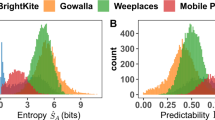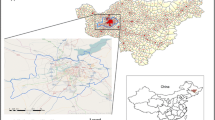Abstract
Personal networks can influence human behavior in many aspects. This article presents a correlation analysis of social tie strength and individual behavior concerning mobility and sociality. The study uses a large-scale mobile phone data (110,213 subjects) from which behavior indicators for both mobility and sociality are inferred and used for the analysis. Mobility diversity, dispersion, and range are considered as mobility behavior indicators. Call frequency, call duration, and degree (number of social ties) are considered for sociality. The results show that people tend to have a more similar behavior with their closer ties for most of considered individual behavior indicators, except for the mobility dispersion.





Similar content being viewed by others
References
Ahas R, Mark U, Järv O, Nuga M (2006) Mobile positioning in sustainability studies: social positioning method in studying commuters activity spaces in Tallinn’ in Mander. In: Brebbia CA, Tiezzi E (eds) The sustainable city IV. Urban regeneration and sustainability, the sustainable city IV. Urban regeneration and sustainability. WIT Press, Southampton, pp 127–135
Ahas R, Aasa A, Silm S, Tiru M (2007) Mobile positioning data in tourism studies and monitoring: case study in tartu, estonia. In: Sigala M, Mich L, Murphy J (eds) ENTER. Springer, pp 119–128
Ahas R, Saluveer E, Tiru M, Silm S (2008) Mobile positioning based tourism monitoring system: Positium barometer. In: O’Connor P, Hpken W, Gretzel U (eds) ENTER. Springer, pp 475–485
Axhausen KW (2006) Social networks and travel: some hypotheses. In: Donaghy K (ed) Social aspects of sustainable transport: transatlantic perspectives, vol 197. Ashgate, Aldershot, pp 90–108
Barabási AL (2009) Scale-free networks: a decade and beyond. Science 325:412
Blondel V, Decuyper A, Krings G (2015) A survey of results on mobile phone datasets analysis. EPJ Data Sci 4(1):1–55
Calabrese F, Reades J, Ratti C (2010) Eigenplaces: segmenting space through digital signatures. IEEE Pervasive Comput 9(1):78–84
Candia J, González MC, Wang P, Schoenharl T, Madey G, Barabási AL (2008) Uncovering individual and collective human dynamics from mobile phone records. J Phys A: Math Theor 41(22):224015
Carrasco J, Miller E, Wellman B (2008) How far and with whom do people socialize? Empirical evidence about the distance between social network members. Trans Res Rec 2076:114–122
Centola D (2011) An experimental study of homophily in the adoption of health behavior. Science 334:1269–1272
Dunbar RIM, Spoors M (1995) Social networks, support cliques, and kinship. Hum Nat 6(3):273–290. doi:10.1007/bf02734142
Eagle N, Pentland AS, Lazer D (2009) Inferring friendship network structure by using mobile phone data. Proc Natl Acad Sci 106(36):15274–15278
Granovetter M (1973) The strength of weak ties. Am J Sociol 78(6):1360–1380
Hill RA, Dunbar RIM (2003) Social network size in humans. Hum Nat 14:5372
Lambiotte R, Blondel V, De Kerchove C, Huens E, Prieur C, Smoreda Z, Van Dooren P (2008) Geographical dispersal of mobile communication networks. Phys A Stat Mech Appl 387(21):5317–5325
Lazarsfeld P, Merton R (1954) Friendship as a social process: a substantive and methodological analysis. In: Berger M (ed) Freedom and control in modern society. Van Nostrand, New York, pp 18–66
Liben-Nowell D, Novak J, Kumar R, Raghavan P, Tomkins A (2005) Geographic routing in social networks. Proc Natl Acad Sci 102(33):11623–11628. doi:10.1073/pnas.0503018102
Licoppe C, Diminescu D, Smoreda Z, Ziemlicki C (2008) Using mobile phone geolocalisation for ‘socio-geographical’ analysis of co-ordination, urban mobilities, and social integration patterns. Tijdschrift voor Economische en Sociale Geografie 99(5):584–601
Liu J, Liu Y, Rau PLP, Li H, Wang X, Li D (2010) How socio-economic structure influences rural users’ acceptance of mobile entertainment. In: Proceedings of the SIGCHI conference on human factors in computing systems, CHI’10. ACM, New York, NY, USA, pp 2203–2212
Liu X, He Q, Tian Y, Lee WC, McPherson J, Han J (2012) Event-based social networks: linking the online and offline social worlds. In: Proceedings of the 18th ACM SIGKDD international conference on knowledge discovery and data mining, KDD’12. ACM, New York, NY, USA, pp 1032–1040
McAuliffe K, Blake PR, Kim G, Wrangham RW, Warneken F (2013) Social influences on inequity aversion in children. PLoS ONE 8(12):e80966. doi:10.1371/journal.pone.0080966
McPherson M, Smith-Lovin L, Cook J (2001) Birds of a feather: homophily in social networks. Annu Rev Sociol 27:415–444
Newman MEJ (2003) Mixing patterns in networks. Phys Rev E 67(2):026126. doi:10.1103/PhysRevE.67.026126
Onnela J, Saramaki J, Hyvonen J, Szabo G, Lazer D, Kaski K, Barabási AL (2007) Structure and tie strengths in mobile communication networks. Proc Natl Acad Sci 104(18):7332–7336
Phithakkitnukoon S, Leong TW, Smoreda Z, Olivier P (2012a) Weather effects on mobile social interactions: a case study of mobile phone users in Lisbon, Portugal. PLoS ONE 7(10):e45745
Phithakkitnukoon S, Smoreda Z, Olivier P (2012b) Socio-geography of human mobility: a study using longitudinal mobile phone data. PLoS One 7(6):e39253
Phithakkitnukoon S, Horanont T, Leong T, Sekimoto Y, Shibasaki R (2013) Weather effects on the patterns of people’s everyday activities: a study using GPS traces of mobile phone users. PLoS ONE 8(12):e81153
Ratti C, Williams S, Frenchman D, Pulselli RM (2006) Mobile landscapes: using location data from cell phones for urban analysis. Environ Plan B Plan Des 33(5):727
Ratti C, Sevtsuk A, Huang S, Pailer R (2007) Mobile landscapes: Graz in real time. In: Gartner G, Cartwright WE, Peterson MP (eds) Location based services and tele-cartography, Lecture notes in geoinformation and cartography. Springer, pp 433–444
Reades J, Calabrese F, Sevtsuk A, Ratti C (2007) Cellular census: explorations in urban data collection. IEEE Pervasive Comput 6(3):30–38
Reades J, Calabrese F, Ratti C (2009) Eigenplaces: analysing cities using the space time structure of the mobile phone network. Environ Plan B Plan Des 36(5):824–836
Seeburger J, Foth M, Tjondronegoro D (2012) The sound of music: sharing song selections between collocated strangers in public urban places. In: Proceedings of the 11th international conference on mobile and ubiquitous multimedia, MUM’12. ACM, New York, NY, USA, pp. 34:1–34:10
Shalizi C, Thomas A (2011) Homophily and contagion are generically confounded in observational social network studies. Sociol Methods Res 40(2):211–239
Sheller M, Urry J (2006) The new mobilities paradigm. Environ Plan A 38(2):207–226
Song C, Koren T, Wang P, Barabási AL (2010a) Modelling the scaling properties of human mobility. Nat Phys 6(10):818–823
Song C, Qu Z, Blumm N, Barabási AL (2010b) Limits of predictability in human mobility. Science 327(5968):1018–1021
Steenbruggen J, Borzacchiello M, Nijkamp P, Scholten H (2013) Mobile phone data from GSM networks for traffic parameter and urban spatial pattern assessment: a review of applications and opportunities. GeoJournal 78(2):223–243
Toole JL, Herrera-Yague C, Schneider CM, Gonzalez MC (2015) Coupling human mobility and social ties. J R Soc Interface 12(105):20141128
Van den Berg P, Arentze T, Timmermans H (2013) A path analysis of social networks, telecommunication and social activity-travel patterns. Trans Res Part C Emerg Technol 26:256–268
Vannoy SA, Palvia P (2010) The social influence model of technology adoption. Commun ACM 53(6):149–153
Acknowledgments
This research has been supported by CMU Junior Research Fellowship Program.
Author information
Authors and Affiliations
Corresponding author
Rights and permissions
About this article
Cite this article
Phithakkitnukoon, S., Smoreda, Z. Influence of social relations on human mobility and sociality: a study of social ties in a cellular network. Soc. Netw. Anal. Min. 6, 42 (2016). https://doi.org/10.1007/s13278-016-0351-z
Received:
Revised:
Accepted:
Published:
DOI: https://doi.org/10.1007/s13278-016-0351-z




